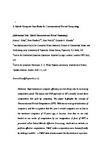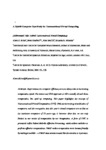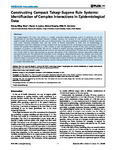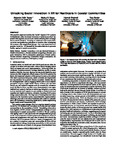A Hybrid Computer Case Study for Unconventional Virtual Computing
| dc.contributor.author | Kirke, Alexis | |
| dc.contributor.author | Shadbolt, P | |
| dc.contributor.author | Neville, A | |
| dc.contributor.author | Miranda, Eduardo | |
| dc.date.accessioned | 2015-10-12T16:29:14Z | |
| dc.date.accessioned | 2016-10-25T13:41:09Z | |
| dc.date.available | 2015-10-12T16:29:14Z | |
| dc.date.available | 2016-10-25T13:41:09Z | |
| dc.date.issued | 2016-03-15 | |
| dc.identifier.issn | 1548-7199 | |
| dc.identifier.issn | 1548-7202 | |
| dc.identifier.uri | http://hdl.handle.net/10026.1/6618 | |
| dc.description.abstract |
Improvements in computer efficiency are not always due to increasing computation speed. The mouse and GUI approach to OS’s actually slowed down computation, but sped up computing. This paper highlights the concept of Unconventional Virtual Computation (UVC). With the increasing virtualization of computers, and the recognition that this year’s virtual computers are as fast as the hardware computers of 10 years ago, it becomes clear that we are only limited in our modes of computation by our imagination. A form of UVC is presented called Pulsed Melodic Affective Processing, which utilizes melodies to perform affective computations. PMAP makes computation more human-friendly by making it audible – a PMAP data stream sounds like the emotion it represents. A hybrid computation system is presented combining UVC PMAP with a Photonic Quantum Computer, in which the PMAP musico-logic circuit keeps the QC in a state of entanglement. | |
| dc.format.extent | 205-226 | |
| dc.language.iso | en | |
| dc.publisher | Old City Publishing | |
| dc.relation.replaces | http://hdl.handle.net/10026.1/3586 | |
| dc.relation.replaces | 10026.1/3586 | |
| dc.subject | Unconventional Virtual Computing | |
| dc.subject | Human-Computer Interaction | |
| dc.subject | Music | |
| dc.subject | Affective Computing | |
| dc.subject | Quantum Computing | |
| dc.subject | Entanglement | |
| dc.title | A Hybrid Computer Case Study for Unconventional Virtual Computing | |
| dc.type | journal-article | |
| dc.type | Article | |
| plymouth.author-url | https://www.webofscience.com/api/gateway?GWVersion=2&SrcApp=PARTNER_APP&SrcAuth=LinksAMR&KeyUT=WOS:000368629300002&DestLinkType=FullRecord&DestApp=ALL_WOS&UsrCustomerID=11bb513d99f797142bcfeffcc58ea008 | |
| plymouth.issue | 3-4 | |
| plymouth.volume | 11 | |
| plymouth.publication-status | Accepted | |
| plymouth.journal | International Journal of Unconventional Computation | |
| plymouth.organisational-group | /Plymouth | |
| plymouth.organisational-group | /Plymouth/Faculty of Arts, Humanities and Business | |
| plymouth.organisational-group | /Plymouth/REF 2021 Researchers by UoA | |
| plymouth.organisational-group | /Plymouth/REF 2021 Researchers by UoA/UoA33 Music, Drama, Dance, Performing Arts, Film and Screen Studies | |
| plymouth.organisational-group | /Plymouth/Users by role | |
| plymouth.organisational-group | /Plymouth/Users by role/Academics | |
| plymouth.organisational-group | /Plymouth/Users by role/Researchers in ResearchFish submission | |
| dcterms.dateAccepted | 2015-05-29 | |
| dc.identifier.eissn | 1548-7202 | |
| dc.rights.embargoperiod | Not known | |
| rioxxterms.licenseref.uri | http://www.rioxx.net/licenses/all-rights-reserved | |
| rioxxterms.licenseref.startdate | 2016-03-15 | |
| rioxxterms.type | Journal Article/Review |






